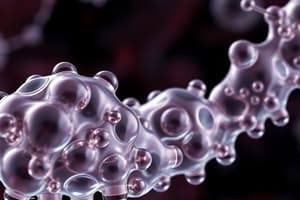Podcast
Questions and Answers
Which of the following is NOT a biological function of lipids?
Which of the following is NOT a biological function of lipids?
- Production of carbohydrates (correct)
- Energy storage
- Hormones
- Structural components of cell membranes
How much energy do lipids provide per gram?
How much energy do lipids provide per gram?
9 kcal
Unsaturated fatty acids contain double bonds.
Unsaturated fatty acids contain double bonds.
True (A)
The main type of fat stored in adipocytes is called _____ .
The main type of fat stored in adipocytes is called _____ .
What group does eicosanoids include?
What group does eicosanoids include?
What is the typical carbon chain length for fatty acids?
What is the typical carbon chain length for fatty acids?
A saturated fatty acid contains double bonds.
A saturated fatty acid contains double bonds.
What is the reaction called when fatty acids react with alcohols to form esters?
What is the reaction called when fatty acids react with alcohols to form esters?
Match the type of lipid with its category:
Match the type of lipid with its category:
Flashcards are hidden until you start studying
Study Notes
Biological Functions of Lipids
- Energy Source: Lipids provide 9kcal of energy per gram, which is more than carbohydrates or proteins.
- Energy Storage: Triglycerides are stored in adipocytes (fat cells) for long-term energy reserves.
- Structural Component of Cell Membranes: Phosphoglycerides, steroids, and sphingolipids are essential components of cell membranes.
- Hormones: Steroids are vital intercellular messengers regulating various bodily functions.
- Lipid-Soluble Vitamins: Vitamins A, E, D, and K are fat-soluble and require dietary fat for absorption.
- Shock Absorption and Insulation: Lipids provide cushioning and insulation for organs and the body.
Classification of Lipids
- Fatty Acids: These are the building blocks of many lipids.
- Saturated Fatty Acids: Have no double bonds between carbon atoms.
- Unsaturated Fatty Acids: Have one or more double bonds between carbon atoms.
- Glycerides: Composed of glycerol and fatty acids.
- Nonglyceride Lipids: This category includes:
- Sphingolipids: Essential for cell membrane structure.
- Steroids: A class of compounds including cholesterol and hormones.
- Waxes: Provide protective coatings for plants and animals.
Fatty Acids
- Structure: Unbranched, long, straight chains of an even number of carbon atoms with a carboxyl group (COOH).
- Length: Most common chains range from 10 to 20 carbons.
- Stearic Acid: A typical saturated fatty acid with 18 carbons.
- Oleic Acid: A typical unsaturated fatty acid with 18 carbons.
Saturated & Unsaturated Fatty Acids
- Saturated Fatty Acids: Have no double bonds between carbon atoms, resulting in more rigid structures that pack tightly.
- Unsaturated Fatty Acids: Have one or more double bonds between carbon atoms, resulting in less rigid structures that pack loosely.
- Cis configuration: In unsaturated fats, the presence of a double bond prevents tight packing, leading to lower melting temperatures.
Unsaturated Fatty Acids
- Double bonds: The first double bond is typically at the ninth carbon atom.
- Cis configuration: The double bonds are usually in the cis configuration, which causes a bend in the fatty acid chain.
Properties of Fatty Acids
- Melting Point: Increases with increasing carbon number.
- Melting Point Comparison: Saturated fatty acids have higher melting points than unsaturated fatty acids with the same number of carbons.
- Packing: Saturated fatty acids pack tightly due to the straight structure, while cis double bonds in unsaturated fatty acids prevent tight packing.
- Double Bonds Effect: Double bonds decrease melting point relative to saturated fatty acids.
Esterification of Fatty Acids
- Esterification: A reaction between a fatty acid and an alcohol, resulting in the formation of an ester and water.
Hydrolysis of Fatty Acids
- Acid Hydrolysis: The reverse of esterification, breaking down esters into fatty acids and alcohols.
Saponification of Fatty Acids
- Saponification: Base-catalyzed hydrolysis of an ester, producing:
- An alcohol.
- An ionized salt (soap).
Soap & Micelle Formation
- Soaps: Soaps have a long, uncharged hydrocarbon tail and a negatively charged carboxylate group at the end.
- Micelles: Soaps form micelles in water, encasing oil and dirt particles for removal.
Reactions at the Double Bond
- Hydrogenation: A chemical reaction that converts unsaturated fatty acids to saturated fatty acids by adding hydrogen.
- Food Industry: Hydrogenation is used to convert liquid vegetable oils into solids.
- Margarine: A common example of a hydrogenated fat.
Eicosanoids: Prostaglandins, Leukotrienes, & Thromboxanes
- Essential Fatty Acids: Cannot be synthesized by the body and must be obtained from the diet.
- Linoleic Acid: An essential fatty acid needed to synthesize arachidonic acid.
- Arachidonic Acid: A 20-carbon unsaturated fatty acid that serves as the precursor for eicosanoids.
- Eicosanoids: A group of structurally similar compounds, including:
- Prostaglandins: Potent biological molecules involved in inflammation and pain.
- Leukotrienes: Involved in allergic and inflammatory responses.
- Thromboxanes: Play a role in blood clotting.
Prostaglandins (PG)
- Production: Produced in most tissues, acting as "local hormones."
- Structure: Derived from 20-carbon unsaturated fatty acids and contain a 5-carbon ring.
- Effects: Exert their effects on nearby cells.
Aspirin & Prostaglandins
- Aspirin Mechanism: Inhibits prostaglandin synthesis by acetylating cyclooxygenase, an enzyme essential for prostaglandin production.
Studying That Suits You
Use AI to generate personalized quizzes and flashcards to suit your learning preferences.




